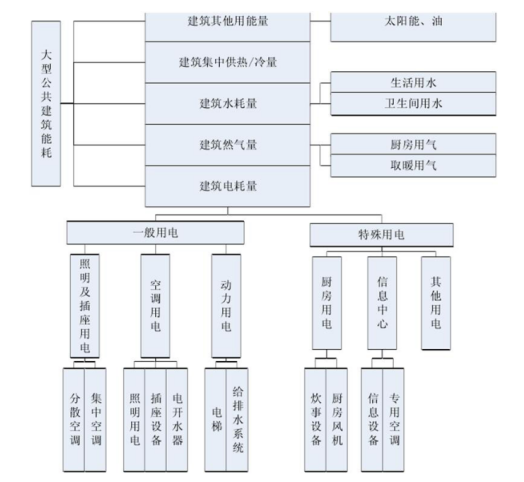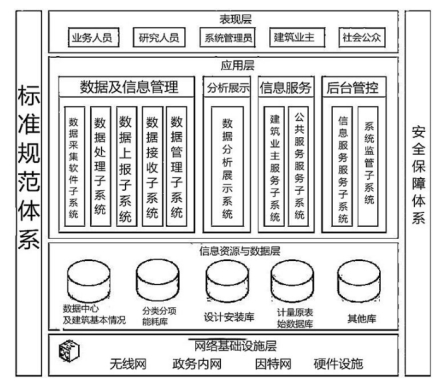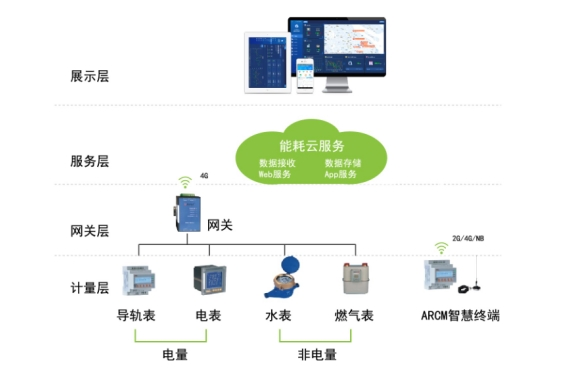安科瑞師晴晴
江蘇安科瑞電器制造有限公司江蘇江陰
背景background
我國建設部提出��,經(jīng)過大數(shù)據(jù)統(tǒng)計分析�,2020年底,國內(nèi)建筑總面積已經(jīng)超過400億平方米���,建筑能耗將達到十點九億噸標準煤�����,建筑在建造和使用過程中直接消耗的能源已占全社會總能耗的百分之三十左右�����。我國當前大型公共建筑能耗在計量�、傳輸����、節(jié)能監(jiān)管層次存在一定問題,粗放式能耗管理在一定程度會造成大量的能耗浪費��,大型公共建筑能耗監(jiān)測與節(jié)能管理已經(jīng)成為我國節(jié)能減耗工作的重心��。雖然我國當前已經(jīng)開展了信息化能好監(jiān)管工作����,但是很多地方因為數(shù)據(jù)采集自動化程度較低,管理信息化程度較低����,在數(shù)據(jù)上報的過程中,存在諸多瞞報問題���,直接增加了能耗數(shù)據(jù)統(tǒng)計的難度��。為了實現(xiàn)能耗數(shù)據(jù)信息采集����,對能源消耗情況進行動態(tài)化管控���,本文將針對大型公共建筑能耗監(jiān)控系統(tǒng)進行詳細分析���。
China's Ministry of construction has proposed that through the statistical analysis of big data, by the end of 2020, the total construction area of the country has exceeded 40 billion square meters, and the building energy consumption will reach 1.09 billion tons of standard coal. The energy directly consumed by buildings in the process of construction and use has accounted for about 30% of the total energy consumption of the whole society. At present, there are some problems in the measurement, transmission and energy-saving supervision of energy consumption of large public buildings in China. Extensive energy consumption management will cause a lot of energy consumption waste to a certain extent. Energy consumption monitoring and energy-saving management of large public buildings have become the focus of energy conservation and consumption reduction in China. Although China has carried out the supervision of informatization, there are many problems of concealment in the process of data reporting, which directly increases the difficulty of energy consumption data statistics because of the low degree of automation of data collection and low degree of management informatization. In order to achieve accurate energy consumption data collection and effective dynamic control of energy consumption, this paper will analyze the energy consumption monitoring system of large public buildings in detail.
一、國內(nèi)外大型公共建筑能耗監(jiān)控系統(tǒng)發(fā)展
development of energy consumption monitoring system for large public buildings at home and abroad
放眼國外來看,國外的智能樓宇技術(shù)已經(jīng)較為成熟��,能耗數(shù)據(jù)信息監(jiān)測的智能化�、自動化水平也相對較高。針對發(fā)達國家來說���,尤其是針對大型公共建筑的能耗監(jiān)控是相當注重的��,智能化能耗監(jiān)測設備也不斷完善�,工程系統(tǒng)運行穩(wěn)定�。針對我國來說,智能樓宇技術(shù)雖然有所運用�����,但是缺乏系統(tǒng)化的智能樓宇集成系統(tǒng)����,相關(guān)觀念、理念并未形成�����,與國外仍然存在較大差距��。我國很多智能樓宇系統(tǒng)在運行的過程中,缺乏相關(guān)系統(tǒng)整體運行機制�����,會造成事半功倍問題����,導致投資浪費���,智能樓宇監(jiān)測系的實時性��、可靠性��、穩(wěn)定性都很難達到世界標準水平����。國外當前很多信息化技術(shù)企業(yè)都已經(jīng)針對大型公共建筑能耗監(jiān)控系統(tǒng)�����,研發(fā)出了與其相匹配的系統(tǒng)性產(chǎn)品����,美國霍尼韋爾��、美國江森自控�、德國西門子等公司�,都進行了能耗監(jiān)測系統(tǒng)產(chǎn)品研發(fā),促使國家大型公共建筑能耗監(jiān)控系統(tǒng)運行更加穩(wěn)定��。我國智能樓宇發(fā)展雖然存在不完善之處�����,但是在國家和企業(yè)的共同努力推動之下�,正在發(fā)展。我國上海元上能耗計量管理系統(tǒng)���、研華地BEMS樓宇能源管理系統(tǒng)�����,都展現(xiàn)出了自身獨特的價值��,在我國大型公共建筑能耗監(jiān)控工作當中運用廣泛����。
Looking abroad, foreign intelligent building technology has been relatively mature, and the intelligent and automatic level of energy consumption data and information monitoring is also relatively high. For developed countries, especially for large public buildings, great attention is paid to energy consumption monitoring, intelligent energy consumption monitoring equipment is constantly improved, and the engineering system operates stably. For China, although intelligent building technology has been applied, it lacks systematic intelligent building integration system, relevant concepts and ideas have not been formed, and there is still a large gap with foreign countries. During the operation of many intelligent building systems in China, the lack of overall operation mechanism of relevant systems will lead to the problem of twice the result with half the effort, resulting in a waste of investment. The real-time, reliability and stability of intelligent building monitoring system are difficult to reach the world standard level. At present, many foreign information technology enterprises have developed matching systematic products for the energy consumption monitoring system of large public buildings. American Honeywell, American Johnson Controls, German Siemens and other companies have actively carried out the research and development of energy consumption monitoring system products, so as to promote the operation of energy consumption monitoring system of national large public buildings to be more stable and efficient. Although there are imperfections in the development of intelligent buildings in China, they are actively developing under the joint efforts of the state and enterprises. China's Shanghai Yuanshang energy consumption measurement and management system and Advantech BEMS building energy management system all show their unique value and are widely used in the energy consumption monitoring of large public buildings in China.
二��、大型公共建筑能耗監(jiān)控數(shù)據(jù)采集
Energy consumption monitoring data collection of large public buildings
2.1能耗監(jiān)控數(shù)據(jù)采集
energy consumption monitoring data collection
大型公共建筑能耗數(shù)內(nèi)部數(shù)據(jù)系統(tǒng)繁雜,并且耗能的單位較多�����,為了做好大型公共建筑能耗監(jiān)控系統(tǒng)構(gòu)架���,要對大型公共建筑能耗監(jiān)控數(shù)據(jù)信息內(nèi)容進行把控。結(jié)合我國頒布的《國家機關(guān)辦公建筑和大型公共建筑的具體內(nèi)容》當中的要求來看��,大型公共建筑能耗數(shù)據(jù)信息監(jiān)控內(nèi)容如圖1所示�。
The internal data system of energy consumption of large public buildings is complex, and there are many energy consuming units. In order to do a good job in the framework of energy consumption monitoring system of large public buildings, it is necessary to control the content of energy consumption monitoring data of large public buildings. According to the requirements in the specific contents of state organ office buildings and large public buildings issued by China, the monitoring content of energy consumption data information of large public buildings is shown in Figure 1.

圖1 能耗監(jiān)控數(shù)據(jù)采集內(nèi)容
Figure 1 energy consumption monitoring data collection content
2.2能耗監(jiān)控數(shù)據(jù)處理
energy consumption monitoring data processing
在開展大型公共建筑能耗監(jiān)測的過程中,可以借助一般性檢驗計量裝置對能耗數(shù)據(jù)信息進行檢測�,在明確能耗計量裝置峰值和谷值的基礎(chǔ)上,對各項數(shù)據(jù)進行監(jiān)控����。針對電能表當中的功率情況進行驗證。為了保障數(shù)據(jù)信息采集��,可以連續(xù)兩次進行數(shù)據(jù)信息采集����,對兩次數(shù)據(jù)信息采集誤差進行把控,確保功率低于之路能耗設備功率的2倍��。在確保數(shù)據(jù)信息采集的基礎(chǔ)上,還需要開展分項能耗數(shù)據(jù)計算��,借助計量裝置開展檢測���,結(jié)合各項能耗指標的計算方法�����,保障計量檢測水平�����。
In the process of energy consumption monitoring of large public buildings, the energy consumption data information can be detected with the help of general inspection and metering devices, and various data can be monitored on the basis of clarifying the peak and valley values of energy consumption metering devices. Verify the power in the watt hour meter. In order to ensure the effectiveness of data and information collection, data and information collection can be carried out twice in a row, and the errors of the two data and information collection can be controlled to ensure that the power is less than twice the peak power of the energy consuming equipment on the road. On the basis of ensuring the accuracy of data information collection, it is also necessary to carry out sub item energy consumption data calculation, carry out detection with the help of metering devices, and ensure the measurement and detection level in combination with the calculation method of various energy consumption indicators.
三�、大型公共建筑能耗監(jiān)控系統(tǒng)構(gòu)建框架
construction framework of energy consumption monitoring system for large public buildings
3.1系統(tǒng)框架
system framework
本文當中所研究的大型公共建筑能耗監(jiān)控系統(tǒng)�����,緊密依照《國家機關(guān)辦公建筑和大型公共建筑能耗監(jiān)測系統(tǒng)——軟件開發(fā)指導說明書》當中的要求開展設計的�,切實滿足了我國規(guī)定的設計標準。大型公共建筑能耗監(jiān)控系統(tǒng)框架搭建模式如圖2所示�,其主要目的便是獲取采集器前端數(shù)據(jù)信息。針對信息資源與數(shù)據(jù)層來說��,便是在大型公共建筑當中�,實現(xiàn)能源消耗的數(shù)據(jù)信息獲取����、傳輸����,將采集到的能耗數(shù)據(jù)信息進行分類。針對應用層來說���,涵蓋了數(shù)據(jù)及信息管理���、分析展示���、信息服務�、后臺管理等四個層次內(nèi)容�,不同層次當中涵蓋了諸多字內(nèi)容。應用層在大型公共建筑能耗監(jiān)控工作當中的功能�,便是用于能耗數(shù)據(jù)信息處理、展示����、數(shù)據(jù)信息監(jiān)測。在應用層當中����,可以將每個功能當成獨立的系統(tǒng)模塊����,在設計應用層模塊時�,應該保障每個處理模塊相對獨立,減少各個模塊之間的相互干擾�����,為后續(xù)能耗數(shù)據(jù)信息處理做鋪墊����。針對表現(xiàn)層來說,便是對社會當中不同角色可以結(jié)合自身的實際需求����,對大型公共建筑能耗數(shù)據(jù)信息進行分析。
The energy consumption monitoring system of large-scale public buildings studied in this paper is designed in close accordance with the requirements of "energy consumption monitoring system of state organ office buildings and large-scale public buildings - software development guidance manual", which effectively meets the design standards specified in our country. The framework construction mode of energy consumption monitoring system for large public buildings is shown in Figure 2. Its main purpose is to obtain the front-end data information of the collector. For the information resources and data layer, it is to achieve the acquisition and transmission of first-hand energy consumption data information in large public buildings, and classify the collected energy consumption data information. For the application layer, it covers four levels: data and information management, analysis and display, information service and background management. Many words are covered in different levels. The function of the application layer in the energy consumption monitoring of large public buildings is used for energy consumption data information processing, display and data information monitoring. In the application layer, each function can be regarded as an independent system module. When designing the application layer module, each processing module should be relatively independent to reduce the mutual interference between each module and pave the way for the subsequent energy consumption data information processing. For the performance layer, it is to analyze the energy consumption data information of large-scale public buildings for different roles in the society in combination with their own actual needs.

圖2 大型公共建筑能耗監(jiān)控系統(tǒng)構(gòu)建框架圖
Figure 2 construction framework of energy consumption monitoring system for large public buildings
3.2軟件構(gòu)架
software architecture
大型公共建筑能耗監(jiān)控工作一般是借助軟件APP進行操控管理的�,在本文當中所提及到的大型公共建筑能耗監(jiān)控系統(tǒng)軟件當中,涵蓋了監(jiān)控終端����、數(shù)據(jù)庫、數(shù)據(jù)管理系統(tǒng)、數(shù)據(jù)采集系統(tǒng)�、防火墻、通信網(wǎng)絡���、集中器�、樓宇數(shù)據(jù)信息采集終端�����。智能樓宇系統(tǒng)所采集到的能耗數(shù)據(jù)信息�,會傳輸?shù)綌?shù)據(jù)集中器當中,將建筑物當中電能表��、水表���、冷量表、氣表等能耗數(shù)據(jù)信息�����、運行狀態(tài)進行集中處理���。集中器會將數(shù)據(jù)信息轉(zhuǎn)換成TCP/IP協(xié)議數(shù)據(jù)包等�,通信網(wǎng)絡在防火墻的作用之下,促使數(shù)據(jù)信息處理模塊運行��,將有關(guān)的能耗數(shù)據(jù)信息傳輸?shù)綌?shù)據(jù)庫當中����。數(shù)據(jù)信息采集系統(tǒng)對集中器當中的樓宇終端通信協(xié)議進行管理,定時對數(shù)據(jù)通信存在的錯誤進行查錯��。針對數(shù)據(jù)丟失���、工作異常等諸多內(nèi)容進行相關(guān)數(shù)據(jù)處理���,獲取數(shù)據(jù)庫當中的相關(guān)數(shù)據(jù)信息,結(jié)合系統(tǒng)設置的能耗監(jiān)測指標���,動態(tài)化對建筑物當中的能耗情況進行監(jiān)控��、測評�、分析�����、存儲�、展示����。監(jiān)控終端一般會從數(shù)據(jù)庫當中獲取相關(guān)數(shù)據(jù)并且得出評估結(jié)果���,對其進行綜合分析把控�。監(jiān)控終端會結(jié)合數(shù)據(jù)庫����、數(shù)據(jù)采集系統(tǒng)����、通信網(wǎng)絡、防火墻���、集中器等����,對控制指令進行分析��,以便于對樓宇的采集終端數(shù)據(jù)信息狀態(tài)把控��。
The energy consumption monitoring of large public buildings is generally controlled and managed with the help of software app. The energy consumption monitoring system software of large public buildings mentioned in this paper covers monitoring terminal, database, data management system, data acquisition system, firewall, communication network, concentrator and building data information acquisition terminal. The energy consumption data information collected by the intelligent building system will be transmitted to the data concentrator for centralized processing of energy consumption data information and operation status such as electric energy meter, water meter, cooling meter and gas meter in the building. The concentrator will convert the data information into TCP / IP protocol packets. Under the action of firewall, the communication network will promote the operation of data information processing module and transmit the relevant energy consumption data information to the database. The data acquisition system manages the building terminal communication protocol in the concentrator and checks the errors in data communication regularly. Conduct relevant data processing for many contents such as data loss and abnormal work, effectively obtain relevant data information in the database, and dynamically monitor, evaluate, analyze, store and display the energy consumption in the building in combination with the energy consumption monitoring indicators set by the system. The monitoring terminal will generally obtain relevant data from the database and obtain the evaluation results for comprehensive analysis and control. The monitoring terminal will analyze the control instructions in combination with the database, data acquisition system, communication network, firewall, concentrator, etc., so as to control the data information status of the acquisition terminal of the building.
四����、大型公共建筑能耗監(jiān)控系統(tǒng)關(guān)鍵技術(shù)
key technologies of energy consumption monitoring system for large public buildings.
4.1多種能耗采集終端接入技術(shù)
multiple energy consumption acquisition terminal access technologies
在大型公共建筑能耗監(jiān)控系統(tǒng)當中,關(guān)鍵的技術(shù)之一便是多種能耗采集終端接入技術(shù)�,以便于對公共建筑當中的多種能耗進行整**集。不同品牌能耗監(jiān)控系統(tǒng)當中的多種能耗采集終端接入技術(shù)存在不同差異�,如何借助一個集中器進行多種能耗采集連接至關(guān)重要。因為不同能耗監(jiān)控系統(tǒng)存在私有協(xié)議��,所以在選擇大型公共建筑能耗監(jiān)控系統(tǒng)時�����,應該對不同品牌的系統(tǒng)進行分析�����,明確各個品牌的私有協(xié)議�����、種能耗采集連接方式�����,保障不同品牌開發(fā)的能耗監(jiān)控系統(tǒng)滿足大型公共建筑的實際使用需求��,確保軟件系統(tǒng)可以順利接入到不同能耗采集終端當中。
In the energy consumption monitoring system of large public buildings, one of the key technologies is a variety of energy consumption acquisition terminal access technology, so as to integrate and collect a variety of energy consumption in public buildings. There are different access technologies of multiple energy consumption acquisition terminals in different brands of energy consumption monitoring systems. How to connect multiple energy consumption acquisition terminals with one concentrator is very important. Because there are private protocols for different energy consumption monitoring systems, when selecting the energy consumption monitoring system of large public buildings, we should analyze the systems of different brands, clarify the private protocols and energy consumption collection and connection modes of each brand, and ensure that the energy consumption monitoring system developed by different brands can meet the actual use needs of large public buildings, Ensure that the software system can be smoothly connected to different energy consumption acquisition terminals.
4.2系統(tǒng)軟件開發(fā)技術(shù)
system software development technology
在實際開展大型公共建筑能耗監(jiān)控系統(tǒng)運用時�����,需要結(jié)合系統(tǒng)的整體框架和模塊分層特點��,引入本軟件平臺的開發(fā)技術(shù)�����。借助Java���、JavaScrip等編程語言進行程序編碼設計�,將數(shù)據(jù)存儲庫與云存儲技術(shù)相銜接�����,確保能耗數(shù)據(jù)信息存儲的**性與巨型容量����。在進行數(shù)據(jù)信息傳輸通訊時,應該選擇穩(wěn)定的RS485數(shù)據(jù)通信標準��,保障存儲數(shù)據(jù)信息高質(zhì)量運行�����。
In the actual application of large-scale public building energy consumption monitoring system, it is necessary to introduce the development technology of this software platform in combination with the overall framework and module layered characteristics of the system. With the help of Java, javascrip and other programming languages for program coding design, the data repository is connected with cloud storage technology to ensure the security and huge capacity of energy consumption data information storage. During data information transmission and communication, a stable RS485 data communication standard should be selected to ensure the high-quality operation of stored data information.
5.安科瑞能耗監(jiān)控系統(tǒng)介紹
Introduction to ankerui energy consumption monitoring system
Acrel-5000能耗在線監(jiān)測系統(tǒng)是用戶端能源管理分析系統(tǒng)�����,在電能管理系統(tǒng)的基礎(chǔ)上增加了對水��、氣�、煤、油����、熱(冷)量等集中采集與分析,通過對用戶端所有能耗進行細分和統(tǒng)計�����,以直觀的數(shù)據(jù)和圖表向管理人員或決策層展示各類能源的使用消耗情況�����,便于找出高耗能點或不合理的耗能習慣�����,節(jié)約能源,為用戶進一步節(jié)能改造或設備升級提供準確的數(shù)據(jù)支撐���。用戶可按照國家有關(guān)規(guī)定實施能源審計����,分析現(xiàn)狀���,查找問題����,挖掘節(jié)能潛力����,提出切實可行的節(jié)能措施,并向縣級以上人民政府管理節(jié)能工作的部門報送能源審計報告��。
Acrel-5000 energy consumption online monitoring system is a user-side energy management and analysis system. Based on the electric energy management system, it adds centralized collection and analysis of water, gas, coal, oil and heat (cooling) capacity. By subdividing and counting all energy consumption at the user-side, it shows the use and consumption of various energy to managers or decision-makers with intuitive data and charts, It is convenient to find out high energy consumption points or unreasonable energy consumption habits, effectively save energy, and provide accurate data support for users' further energy-saving transformation or equipment upgrading. Users can implement energy audit in accordance with relevant national regulations, analyze the current situation, find problems, tap energy-saving potential, put forward practical energy-saving measures, and submit energy audit reports to the administrative department of energy conservation of the people's government at or above the county level.
5.1平臺結(jié)構(gòu)
platform structure
Acrel-5000能耗在線監(jiān)測系統(tǒng)以計算機��、通訊設備��、測控單元為基本工具���,根據(jù)現(xiàn)場實際情況采用現(xiàn)場總線��、光纖環(huán)網(wǎng)或無線通訊中的一種或多種結(jié)合的組網(wǎng)方式����,為大型公共建筑的實時數(shù)據(jù)采集及遠程管理與控制提供了基礎(chǔ)平臺��,它可以和檢測設備構(gòu)成任意復雜的監(jiān)控系統(tǒng)�����。開放性���、網(wǎng)絡化�、單元化�、組態(tài)化的采用面向?qū)ο蟮姆謱印⒎旨?、分布式智能結(jié)構(gòu)。建立如下層次結(jié)構(gòu):
Acrel-5000 energy consumption online monitoring system takes computers, communication equipment and measurement and control units as basic tools, and adopts one or more combined networking modes of fieldbus, optical fiber ring network or wireless communication according to the actual situation of the site, providing a basic platform for real-time data acquisition, remote management and control of large public buildings, It can form any complex monitoring system with detection equipment. It is open, networked, unitized and configurable, and adopts the object-oriented hierarchical, hierarchical and distributed intelligent integrated structure. Establish the following hierarchy:

圖3 平臺結(jié)構(gòu)
Figure 3 platform structure
5.2平臺功能
platform functions
(1)系統(tǒng)可按使用年份統(tǒng)計建筑物各分類能耗——電�����、水��、氣����、集中供熱��、集中供冷以及其它能源消耗量�����,自動折算成相應的標準煤消耗量�����,從而反映建筑物當年各分類能耗用能和綜合能耗���。系統(tǒng)以餅圖形式展示建筑4大用電分項能耗的占比情況。系統(tǒng)以曲線圖形展現(xiàn)各類能耗的消耗的消耗趨勢�����,便于業(yè)主方實時直觀掌握能源消耗情況�。
(2)系統(tǒng)可以根據(jù)分類能耗的支路名稱查詢用能情況,顯示當日和當月的用能峰值���。顯示當日用能�、當月用能、當年用能與昨日同期用能��、上月同期用能�����、上年同期用能的比較情況����。以條形顯示過去48小時�、31天、12個月���、3年的能耗情況���。右上角顯示過去15分鐘曲線(電表顯示功率曲線,流量表顯示流速曲線)��。
(3)系統(tǒng)依據(jù)建筑物能源消耗的分布情況進行能耗計量點的選取和設置��,使得能耗監(jiān)測系統(tǒng)可以覆蓋整個建筑物�����。系統(tǒng)使用者可通過相關(guān)界面調(diào)取該建筑物各能耗節(jié)點的能耗統(tǒng)計報表,減少用能的“跑��、冒���、滴�、漏”和計量誤差���。
(4)系統(tǒng)依據(jù)住建部分類分項能耗數(shù)據(jù)采集導則�����,將建筑物耗電分為照明插座����、空調(diào)�����、動力和特殊用電進行計量裝置選型和設置��,并按用能區(qū)域或功能區(qū)域等劃分并進行統(tǒng)計�����,以報表和同、環(huán)比棒圖形式展現(xiàn)該區(qū)域的能源消耗��。
(5)系統(tǒng)可針對能源消耗量大的設備或區(qū)域進行準確定位�����,便于管理層制定節(jié)能績效考核制度���,推動節(jié)能降耗的執(zhí)行�����。為用能設備建立運行記錄檔案,長期跟蹤記錄設備運行過程中的能效分析評估結(jié)果����,結(jié)合設備維護保養(yǎng)記錄,為設備的運行維護提供依據(jù)�����。
(6)系統(tǒng)提供分級權(quán)限管理功能�,對具備權(quán)限用戶提供開放的信息維護接口,用戶可自行對建筑和系統(tǒng)監(jiān)測范圍內(nèi)計量點的信息進行增�、刪�����、改和查詢�,建筑物信息包括建筑類型���、建設年代�、建筑面積�����、建筑物人員數(shù)量等���。系統(tǒng)還對無法自動采集的計量信息提供手動錄入功能����,便于使用者掌握建筑物總體能耗情況�。
(1) The system can count the energy consumption of each classification of buildings - electricity, water, gas, central heating, central cooling and other energy consumption according to the service year, and automatically convert it into the corresponding standard coal consumption, so as to reflect the energy consumption and comprehensive energy consumption of each classification of buildings in the current year. The system displays the proportion of the energy consumption of the four major power sub items of the building in the form of pie chart. The system shows the consumption trend of various energy consumption with curves and graphs, which is convenient for the owner to grasp the energy consumption in real time and intuitively.
(2) The system can query the energy consumption according to the branch name of classified energy consumption, and display the peak energy consumption of the current day and the current month. It shows the comparison of energy consumption of the current day, the current month, the current year and the same period of yesterday, the same period of last month and the same period of last year. The energy consumption in the past 48 hours, 31 days, 12 months and 3 years is displayed in a bar. The upper right corner shows the curve of the past 15 minutes (the electricity meter shows the power curve and the flow meter shows the flow rate curve).
(3) The system selects and sets energy consumption measurement points according to the distribution of building energy consumption, so that the energy consumption monitoring system can cover the whole building. The system user can access the energy consumption statistical report of each energy consumption node of the building through the relevant interface to reduce the "running, emitting, dripping and leakage" and measurement error of energy consumption.
(4) According to the guidelines for energy consumption data collection of sub items of residential buildings, the system divides the power consumption of buildings into lighting sockets, air conditioners, power and special power, selects and sets metering devices, divides and makes statistics according to energy consumption areas or functional areas, and displays the energy consumption of the area in the form of statements and comparison bar charts.
(5) The system can accurately locate equipment or areas with large energy consumption, so as to facilitate the management to formulate energy-saving performance evaluation system and promote the effective implementation of energy conservation and consumption reduction. Establish operation record files for key energy consuming equipment, track and record the energy efficiency analysis and evaluation results during equipment operation for a long time, and provide basis for equipment operation and maintenance in combination with equipment maintenance records.
(6) The system provides hierarchical authority management function and provides open information maintenance interface for users with authority. Users can add, delete, modify and query the information of buildings and measurement points within the monitoring range of the system. Building information includes building type, construction age, building area, number of building personnel, etc. The system also provides manual input function for measurement information that cannot be automatically collected, so that users can master the overall energy consumption of buildings.
5.3數(shù)據(jù)上傳
data upload
安科瑞能耗在線監(jiān)測系統(tǒng)按照用能單位能耗在線監(jiān)測系統(tǒng)技術(shù)規(guī)范定義的系統(tǒng)平臺接口協(xié)議規(guī)范的要求,將用能企業(yè)的基礎(chǔ)信息��、計量器具信息����、用能數(shù)據(jù)及能效數(shù)據(jù)上傳至省級或國家平臺���,上傳數(shù)據(jù)經(jīng)過HTTPS協(xié)議加密傳輸。如果數(shù)據(jù)傳輸失敗或超時(網(wǎng)絡故障)���,將重發(fā)數(shù)據(jù)���,直至接收成功反饋消息。
According to the requirements of the system platform interface protocol specification defined in the technical specification of the on-line monitoring system for energy consumption of key energy users, the on-line monitoring system for energy consumption of ankerui will upload the basic information, measuring instrument information, energy consumption data and energy efficiency data of energy consuming enterprises to the provincial or national platform, and the uploaded data will be encrypted and transmitted through HTTPS protocol. If the data transmission fails or times out (network failure), the data will be retransmitted until a successful feedback message is received.
5.4能源計量表具選型
selection of energy meters



六����、結(jié)束語
Conclusion
總而言之,大型公共建筑能耗監(jiān)控系統(tǒng)自身具備一定優(yōu)勢��,在運行的過程中可以滿足當前社會綠色節(jié)能發(fā)展需求�����。為此�����,應該結(jié)合我國當前建筑事業(yè)發(fā)展需求���,對大型公
共建筑能耗監(jiān)控系統(tǒng)以及相關(guān)設備進行**��,完善能耗監(jiān)控系統(tǒng)相關(guān)配套設施��,動態(tài)化及時對大型公共建筑的能耗進行分析�,及時發(fā)現(xiàn)造成能耗過多造成的問題�����,并有針對性的進行改進�,踐行我國及世界節(jié)能減耗發(fā)展需求。
In a word, the energy consumption monitoring system of large public buildings has certain advantages, and can meet the current social green energy-saving development needs in the process of operation. Therefore, in combination with the current development needs of China's construction industry, we should actively innovate the energy consumption monitoring system and related equipment of large public buildings, improve the relevant supporting facilities of the energy consumption monitoring system, dynamically and timely analyze the energy consumption of large public buildings, timely find the problems caused by excessive energy consumption, and make targeted improvements, Truly implement the development needs of energy conservation and consumption reduction in China and the world.
作者簡介:
師晴晴(1987-)����,女,漢族�,本科,工程師����,主要研究方向為智能建筑供配電監(jiān)控系統(tǒng)
T:0510-86189390
M:18860995120(微信同號)
F:0510-86179930
QQ:2880157874
E-MAIL:2880956075@qq.com
網(wǎng)址:http://acrel-ecc.cn
